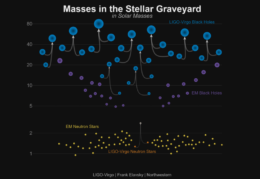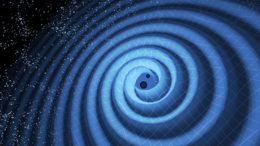The Laser Interferometer Gravitational-wave Observatory (LIGO) and the Virgo interferometer have been turning up more and more binary black hole mergers in their observing runs. Do the black holes involved in these mergers have anything in common or are they paired purely by chance?
Binary Black Holes and Where They Come From
The question of how binary black holes (BBHs) form is still wide open, further complicated by the fact that the masses of the black holes involved are higher than expected. Some astronomers have suggested that BBHs are the result of massive stars that were already in binaries, while others have proposed scenarios where black holes in dense stellar populations encounter each other and pair off. Another possibility is that the black holes in BBHs formed as they are in the early universe — skipping existence as a star — and ended up in binaries.
BBH mergers are a good way to study BBHs themselves; properties of the merger components (like mass) are imprinted into the resulting gravitational waves. In their first two observing runs, LIGO and Virgo spotted ten BBH mergers, and the black holes involved appear to have masses ranging from 18 to 84 solar masses.In a new study, Maya Fishbach and Daniel Holz (The University of Chicago) explored how BBHs pair off in terms of their masses. And they found something interesting — it turns out the black holes in binaries may have more in common with each other than we thought!
Underlying Distributions
Fishbach and Holz attempted to understand BBH pairing through different black hole mass distributions. Broadly speaking, they considered three scenarios:

This plot shows, in blue, the estimated masses without uncertainties for the black holes that LIGO detected in binaries during its first two observing runs. When uncertainties are included, all 10 of LIGO’s detected systems are consistent with having equal component masses. [LIGO-Virgo/Frank Elavsky/Northwestern U.]
- The black hole masses come from a distribution that is only constrained by minimum and maximum masses.
- The black hole masses come from a distribution that depends on minimum and maximum masses, and the ratio between the masses of the black holes in a BBH.
- The black hole masses come from a distribution that depends on minimum and maximum masses, the mass ratio between the BBH components, and the total mass of the BBH.
On modeling and applying these scenarios to the ten available BBH merger observations, Fishbach and Holz came away with two main findings: random pairings are thoroughly disfavored, and black holes in BBHs are five times more likely to be of similar mass than not. They also find that total system mass may not play a big role in BBH pairing.
The BBH formation models that end with black holes of similar mass are usually those that involve massive stellar binaries. This doesn’t rule out other formation mechanisms but Fishbach and Holz’s work suggests that future models may need to account for the mass ratio in BBHs.
Of course, this work is based on only ten observations. However, with more observations from LIGO/Virgo already on the way, astronomers will soon be able to further constrain and eventually solve this puzzle.
Citation
“Picky Partners: The Pairing of Component Masses in Binary Black Hole Mergers,” Maya Fishbach and Daniel E. Holz 2020 ApJL 891 L27. https://doi.org/10.3847/2041-8213/ab7247


9 Comments
Pingback: Połączenie partnerów? Może – PTMA Kraków
Pingback: What Kinds of Black Hole Partners Merge? – Digital VanLife Magazine
Pingback: What Kinds of Black Hole Partners Merge? – Sky & Telescope – Ten15AM
Pingback: What Kinds of Black Hole Partners Merge? – Sky & Telescope | SPACE FORCE
Pingback: What Kinds of Black Hole Partners Merge? – Storm-Tech Nomad
Pingback: What Kinds of Black Hole Partners Merge? » What's Goon
Pingback: What Kinds of Black Hole Partners Merge? -
Pingback: What Kinds of Black Hole Partners Merge? - Sky & Telescope - Worldika - New Platform For Explore World
Pingback: What Kinds of Black Hole Partners Merge? – Sky & Telescope – Dinezh.com